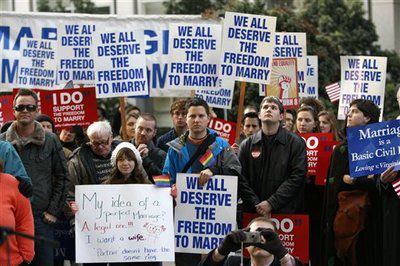The United States Supreme Court today made permanent its ban on any television coverage of the Proposition 8 (gay marriage) trial going on in San Francisco.(See the order)
For the most part, the court’s order stayed away from the ongoing debate on whether televising federal court cases is a good idea. But it said (a) the court in San Francisco doesn’t have the authority to change the current ban and (b) some of those testifying in the case could be harmed if people actually saw it:
The trial will involve various witnesses, including members of same-sex couples; academics, who apparently will discuss gender issues and gender equality, as well as family structures; and those who participated in the campaign leading to the adoption of Proposition 8. This Court has recognized that witness testimony may be chilled if broadcast. See Estes v. Texas, 381 U. S. 532, 547 (1965); id., at 591 (Harlan, J., concurring). Some of appli-cants’ witnesses have already said that they will not tes-tify if the trial is broadcast, and they have substantiated their concerns by citing incidents of past harassment. See, e.g., Exh. K to Defendant-Intervenors’ Motion (71 news articles detailing incidents of harassment related to people who supported Proposition 8). These concerns are not diminished by the fact that some of applicants’ witnessesare compensated expert witnesses. There are qualitative differences between making public appearances regarding an issue and having one’s testimony broadcast throughout the country.
But the court did not indicate what those differences are.
The trial will have already been broadcast. It is difficult to demonstrate or analyze whether a witness would have testified differently if his or her testimony had not been broadcast. And witnesses subject to harassment as a result of broadcast of their testimony might be less likely to cooperate in any future proceedings.
In dissenting from the court’s order, Justice Stephen Breyer pointed out the obvious:
All of the witnesses supporting the applicants are alreadypublicly identified with their cause. They are all experts or advocates who have either already appeared on televi-sion or Internet broadcasts, already toured the State advocating a “yes” vote on Proposition 8, or already engaged in extensive public commentary far more likely to make them well known than a closed-circuit broadcast to another federal courthouse.
The likelihood of any “irreparable” harm is further diminished by the fact that the court order before us would simply increase the trial’s viewing audience from the occupants of one courtroom in one courthouse to the occupants of five other courtrooms in five other court-houses (in all of which taking pictures or retransmissions have been forbidden). By way of comparison literally hundreds of national and international newspapers are already covering this trial and reporting in detail the names and testimony of all of the witnesses.
At the trial today, evidence presented said a proponent of California’s same-sex marriage ban warned voters during the 2008 campaign that gay rights activists would try to legalize sex with children if same-sex couples had the right to wed.
Minnesota’s court system has wrestled with the cameras issue for years and is slowly opening up trial courts to cameras in a few weeks. “I think for many of them… let’s just say I don’t think their heart is in this,” Jane Kirtley, the professor and director of the Silha Center for the Study of Media Ethics and Law at the University of Minnesota said on MPR’s Midday today. “They’re not convinced cameras in the courts are a good thing.”
“It’s very frustrating, not because anyone has an agenda to torpedo this, but the resistance to cameras in the courtroom in this state I find extraordinary,” she said, noting that victims rights groups are vocal about the harm a camera can do. .

